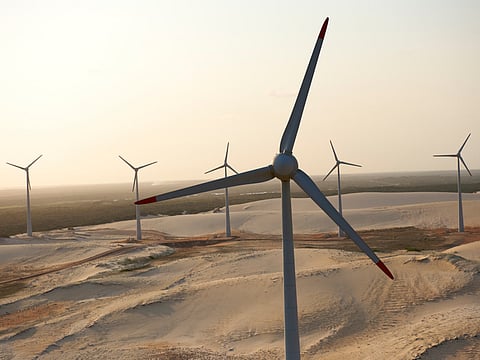Gulf’s renewables plans feel some headwinds blowing in
Ironically, oil price declines are what might delay transition to clean energy

Also In This Package
Despite an abundance of fossil fuels and the impact of the pandemic, countries in the Middle East are still forging ahead with international and local renewables projects. The oil-rich Gulf is among the areas benefiting most from the global appetite for these projects. The UAE, Saudi Arabia, Qatar and Oman are the four Gulf countries that have developed renewables projects over the last few years.
Saudi Arabia is expected to lead the push in the Middle East in the next few years, having launched several renewables projects, including its first wind farm, to free up crude burned in power plants for export. The country’s third renewables round - which would add 1.2 GW of solar capacity - is advancing after 49 companies pre-qualified for lead roles. The kingdom announced it would “very soon” announce a solar energy project with the lowest electricity cost per kilowatt-hour in the world.
Strip down the barriers
Record-low tariffs and plans to reduce dependence on crude oil and natural gas as feedstock for power and energy-intensive water desalination plants are the main factors behind the rapid development of renewables in the region. But growth would be even faster if regulatory barriers to new market entrants outside of auctions were removed, according to the International Energy Agency.Examples include the world’s first large-scale chemical production site to be run entirely on renewable power pioneered by Saudi Basic Industries Corp., majority-owned by Saudi Aramco.
A bit of go slow
However, both Kuwait and Saudi Arabia have delayed renewables programmes, raising questions about their respective renewable goals, according to S&P Global Platts Analytics. Even before the pandemic, Saudi Arabia had put on hold a $200 billion solar project with Japan’s Softbank Group.
Although there are risks from the pandemic, most renewables projects haven’t been rolled back or cancelled, potentially showing how environmental, social and governance concerns have become more central to oil-exporting countries. Saudi Arabia has set a target of 27.3 GW of renewables by 2024.
“Even if Saudi Arabia continues to lag behind in terms of installed capacity and projects, we think the country will catch up within the next few years to become the largest player for renewables in the region next to UAE,” according to Bruno Brunetti, head of global power planning at Platts Analytics.
Laying down markers
S&P Global Platts Analytics expect renewables capacity in the Middle East to more than double within the next five years, building on almost 7 GW of utility-scale solar and 1.5 GW of wind projects in development. Solar and wind accounted for about 1 per cent of power production in the Middle East in 2019, according to the S&P Global Platts World Energy Demand Model. It is expected to be slightly higher at around 1.3 per cent or roughly 8 TWh in 2020, and about 3 per cent of the total almost 35 TWh by 2025.
The UAE targets 50 per cent clean energy by 2050, including nuclear power, with renewables playing a lead role. It has conducted several large-scale competitive solar auctions that yielded low prices, and Abu Dhabi’s 2 GW tender in April drew close to global record-low solar bid of $13.50/MWh, submitted by TAQA, France’s EDF and China’s Jinko Solar for a 30-year contract. It will be the largest solar farm in the world, joining plants in China, India and Egypt with capacity of over 1 GW.
Further, the Dubai Electricity & Water Authority (DEWA) this year awarded Saudi Arabia’s ACWA Power the 900-MW fifth phase of the Mohammed bin Rashid Al Maktoum Solar Park, a project that aims to have 5 GW of solar power by 2030 at a cost of Dh50 billion ($13.6 billion).
Hinging on oil
Oman this year began operations of its first utility-scale solar power plant, which will free up 95.5 million cubic meters a year of natural gas for export. In July, ACWA Power, the Saudi future city of NEOM and the US’s Air Products, signed a $5 billion deal to build a green hydrogen-based ammonia production facility powered by renewable energy.
According to a survey published in May by UK-based law firm Ashurst, only 18 per cent of executives in the Middle East expect to see growing opportunities to invest in the energy transition in the next 12 months, the lowest percentage globally. The jury is still out on whether the coronavirus will slow future renewables plans in the region. While many projects are already in the later stages of development, the low oil prices currently could limit support available for renewables.
- Claudia Carpenter and Dania Saadi are with the Middle East Oil Team at S&P Global Platts.
Sign up for the Daily Briefing
Get the latest news and updates straight to your inbox









